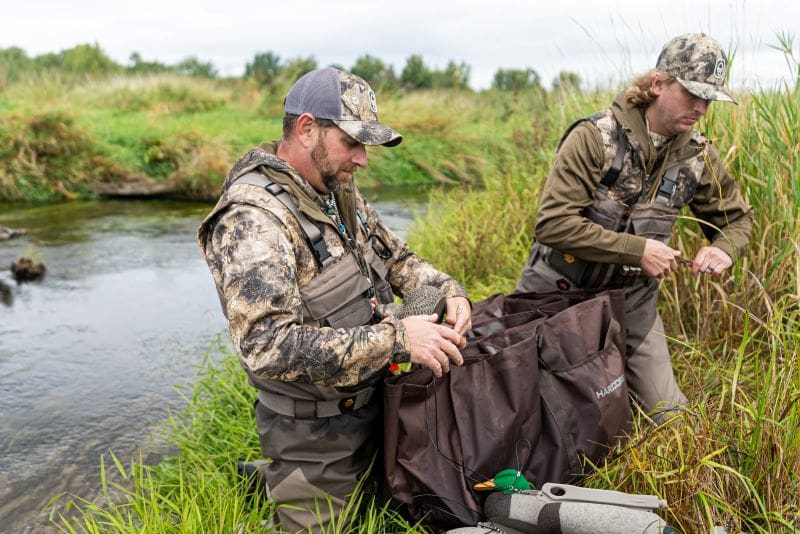Waterfowlers are serious about their hobby. They have to be to be successful. If you’re looking to get into bow hunting, all you need is a crossbow or compound bow and a tree stand, and you’re in business. Waterfowling requires a much more significant investment. You might start with a bag of decoys, grandpa’s shotgun and a pair of waders like most of us did, but you quickly realize you need more equipment- like a boat.
If you’re a novice waterfowler, your initial boat might not be much. You quickly realize that a small pram, jon boat, or canoe is a big help for transporting decoys and other gear, especially when accessing flooded croplands and timber or public hunting.

Public hunting can be a numbers game, so a vessel that helps you haul more decoys can up your odds of success. It doesn’t have to be anything fancy, just functional. Most introductory watercraft are found by perusing yard sales and rummage sales or scanning postings on Marketplace. The find may need some patching and paint, but the investment won’t owe you a thing after a season or two.//
Most of us quickly realize we need more. A boat with a motor on it gives us more access and flexibility. Even a smaller craft with an engine can get you away from access sites and other hunters. I have a 1974 StarCraft with a deep-v hull that has been my go-to duck boat for decades. The boat leaks a little, but adding a bilge pump and epoxy to the rivets on the inside of the hull has stemmed any serious concerns about taking on water. Being that the boat is old, it has twice the aluminum in it than boats made today, but it’s also heavy. The weight is a hindrance when you don’t have it perfectly centered on the trailer because you can’t pick it up and move it, but the weight also makes it sturdy and advantageous in choppy water.
I added a modest trolling motor that I got for free, which is handy when setting and picking up decoys. It makes It easy to maneuver and avoid decoy lines.
The boat came with an Avery Quick-Set blind, which means you can hunt just about anywhere. The blind goes up and down quickly and provides concealment when there isn’t any. It’s always good to have some additional camouflage material to cover things like motors and gas cans, or if you want to get out on shore to make an impromptu blind. The leafy camouflage you can buy at army surplus stores is perfect. You can also buy lightweight camo material at many discount stores.
A flat-bottomed jon boat can be a good choice, too. A jon boat affords a steady platform that offers plenty of room and can haul a lot of gear. Although not as seaworthy as a deep-v, a flat-bottom boat works fine in most waterfowling situations. You can find jon boat hulls from 10 feet to over 20 feet.
A bigger boat with a motor allows you to expand your horizons. You can access and hunt inland lakes, western reservoirs, and the Great Lakes if you use your head and are cautious. A bigger boat will allow you to target diving ducks and the immense water they generally frequent. Targeting divers means deploying larger spreads of decoys, but that is made easier by using decoys rigged with halibut clips that you can attach to mother lines to deploy long lines of decoys quickly.
Each decoy has about three feet of line attached to the clip. A heavy weight is attached to one end of the main line and allowed to hit the bottom, and then decoys are clipped to the line from five to 10 feet apart as the boat drifts. You can make the strings as long as you like by attaching additional lines. A second anchor secures the line. Divers typically gravitate to the long line and funnel into the main body of your spread.

Additional lines can be deployed parallel to the mainline to simulate a flock of resting ducks. Even though the decoys are attached to one long line, it’s incredible how lifelike they look. A good setup is to create a J-hook that directs ducks to the middle of your spread. Create the lead line of decoys using the mother lines, then use individual decoys to make the closed J part of the spread. Position the boat at the upwind end of the J or anchor parallel to the long lines.
As you become more addicted to the sport, you’ll discover other specialized boats created for waterfowling. If you’ve never hunted from a layout boat, you owe it to yourself to try it at least once. The optics of being at eye level with the approaching ducks in the bouncing waves is surreal. Scull boats employ an old-school method few waterfowl hunters practice today.
Mud motors have become all the rage in recent years. With many manufacturers, designs, and options, mud motors allow you to get into mudflats, marshes, and flooded timber where you can’t go with an outboard. The motors are paired to wide, rugged, shallow draft aluminum hulls. In many situations, they are the ultimate duck boat.

At the other end of the scale are boats designed just for hunting big water. They have thick fiberglass hulls up to 26 feet long and powerful outboards with options for permanent blinds, dog ladders, USB outlets, grassing rails, and plenty of storage.
If you stay in the waterfowling game for long, it’s quite likely you’re going to end up with a fleet of duck boats.

